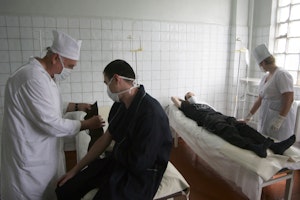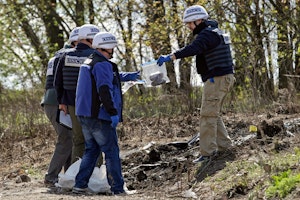The Struggle of Displaced Journalists in Ukraine
By Ilona Sabera
When Victoria Kryat, a young journalist from the town of Krasny Luch in the Luhansk region, came to Kyiv in August 2014, she had 300 grivnas (US$12) in her pocket. Her former workplace, a Ukrainian language TV channel called Luch, had been taken over by pro-Russia fighters.
“At first, various military groups were coming and asking us to broadcast them,” she recounts. “Then armed men stormed our office, consisting mainly of female staff, and told us we were hiding [members of the] Pravyi Sektor [a right-wing Ukrainian political party]. They probably had an order to get control of all the media.” Most of her colleagues had to leave the channel and move to other parts of Ukraine.
Two years have passed since the Euromaidan protests in Kyiv ousted President Viktor Yanukovych in February 2014. What followed was one of the most violent years in recent Ukrainian history. Pro-Russian gunmen took control of the Crimean Peninsula, while in the eastern Donbass region, separatist groups declared Donetsk and Luhansk to be independent republics.
As a result, in the cities of Luhansk and Donetsk, a number of media outlets were forced to close down, move their offices to government-controlled territory, or compromise their editorial independence. The annexation of Crimea by Russia and the military conflict in the eastern part of the country led to assaults, censorship, and intimidation of journalists and media outlets. According to the Kyiv-based Institute of Mass Information, the number of press freedom violations in 2014 increased by 50 percent compared to 2013. That was also a year when Ukrainian journalists, fleeing both military conflict and professional intimidation, became internally displaced and were forced to start over in other cities.
“I had to make a choice between freedom and working and living in Crimea. I had to begin my life from zero in Kyiv,” says journalist Serhiy Mokrushyn. While working for the Centre for Investigative Journalism in Simferopol (now based in Kyiv), he and his colleague Vladlen Melnykov were abducted by so-called self-defense forces in June 2014. Mokrushyn is now a host of an independent television program Hromadske.Krym, broadcast online, on cable, and on satellite television. The program has been highlighting human rights violations against the ethnic minority of Crimean Tatars.
“Now we cannot purely do reporting, we have to be a platform between civil society and the government,” he says. The Crimean journalist also recognizes a need for independent and analytical information in the annexed territory. Most of the Ukrainian media outlets, including the Hromadske website, are blocked in Crimea, creating a media vacuum that is populated by biased news and pro-Russian propaganda.
Today there are 1.7 million internally displaced people from Crimea, Donetsk, and Luhansk, according to the Ministry of Social Policy. People from Crimea started to flee prior to the unconstitutional referendum on the annexation of the peninsula in March 2014, while those from the eastern regions left their homes following escalation of the conflict between the Ukrainian army and pro-Russian separatists in May 2014. According to an estimate by the National Union of Journalists in Ukraine, there might be up to 600 displaced media workers, with most of them coming from the Donbass region and around 100 coming from Crimea.
Broadcast reporter Maria Ivanova was working for the regional channel Donbass in Donetsk. The scenario that played out there was similar to what happened in Luhansk. After several visits by armed men, the channel’s management banned employees from coming to work for their safety. Part of the staff was then moved to Dnipropetrovsk.
“We thought this will last for a couple of months,” she says. “Then I saw that nothing is changing and those territories are becoming frozen conflict zones. I started to worry because I did not have a proper place to live for me and my family.” Maria’s contract was eventually terminated and she had to make her living from a scarce unemployment benefit for five months before finding temporary work at another channel.
In addition to individual journalists, newsrooms formerly based in Donetsk, Luhansk, or Crimea have become exiled media in their own country. They struggle to reach audiences in a territory that is no longer part of Ukraine. “No one is talking to people in the occupied territories. Private media outlets are forbidden. Radio is the easiest way to get there. State [pro-Russian] controlled media broadcast concerts and celebrations. Still, people have a need for critical information because the life doesn’t get any better,” says Serhiy Harmash, editor in chief of the Eastern Ukrainian news site OstroV.
Many displaced people still have families left in the occupied territories. While few journalists are able to return due to being blacklisted by separatists, some still try to visit their loved ones. When Victoria Kryat went back to Krasny Luch to visit her mother for the first time in a year, they spent most of the time indoors, fearing for their safety. And while Victoria made it back to Kyiv, the former Luch reporter still gets harassed on social media. “They call me Kyiv’s spy,” she says. “It looks funny, but it is sad. We did a lot for the city, and it hurts how they treat us now.”
Ilona Sabera is a program specialist with the Open Society Program on Independent Journalism.


